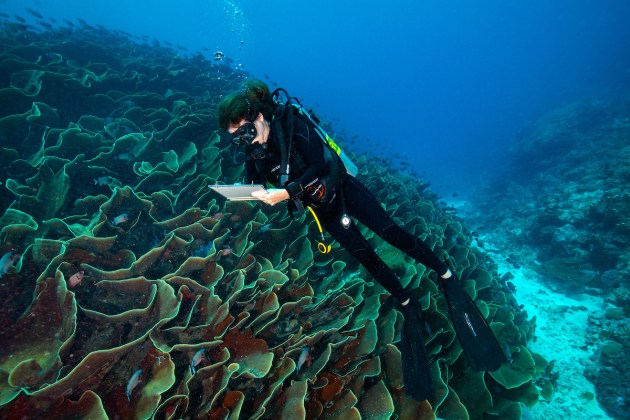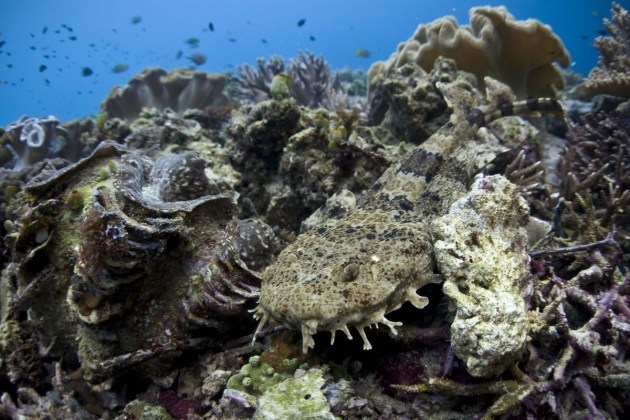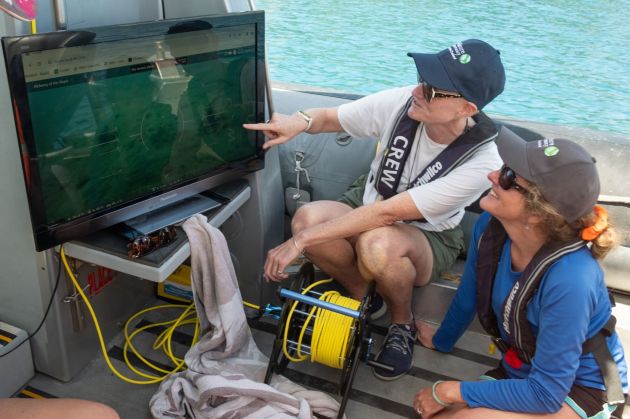Lizzie McLeod laughs at the memory: She’s rushing from her job at a local bank to The Nature Conservancy’s office in Honolulu, Hawai‘i. There, she’d spend her lunch hour in a dark room/closet scanning a marine biologist’s old slides to digital.
McLeod, now The Nature Conservancy’s Global Director for Oceans, has fond memories of those days. “I began with TNC as a volunteer in a dark room,” she says. “But then again, just about everything about my career path was unconventional.”
Many kids grow up dreaming of becoming a marine biologist, fueled by thoughts of saving coral reefs. Although McLeod grew up loving the beach and water, she didn’t consider coral reefs to be her life’s calling, at least not at first.
She graduated from Colorado College with a degree in Asian religion and philosophy. “See what I mean? Unconventional,” she says, laughing again. And it would become perhaps more so.
Her mom invited her and her sister on a trip to the Caribbean. She decided to move there after college to become a glass blower. She went scuba diving. “And I was blown away by what was beneath the surface,” she says. “I felt like an astronaut, floating in space, neutrally buoyant, surrounded by fishes and corals of every color of the rainbow.” She was immediately hooked.

She married her dive instructor and moved to Hawaii and began researching her options. She came across an online series titled “Postcards from the Field,” written by TNC marine biologist Rod Salm. Salm was a legendary figure in the organization, an old-school adventurer who spun lengthy yarns that often began with something like “One time when I was swimming in Palau, and had to resuscitate a frog …”
From a Dark Room to the Reef
McLeod volunteered to work for Salm. He had a massive slide library he wanted converted to digital, which is how she ended up in the dark room. And while scanning hundreds of slides could be tedious, she was drawn to the astonishing diversity of marine life Salm had photographed in Raja Ampat, Indonesia—considered by many to be the heart of marine biodiversity.
“I learned a lot just spending time with those slides,” she says. “I saw hundreds of different species of corals, examples of coral bleaching, and blast-fishing damage on reefs. I saw a wobbegong. I had never heard of a wobbegong. They are super cool. It’s a shark that looks like a carpet with these weird weed-like whisker lobes hanging from its jaw. I wanted to work in a place that had wobbegongs.”

After volunteering for a while, Salm was hiring a program assistant. Mcleod jumped at the opportunity. In her job interview, Salm asked her she wanted to do, and she replied, “I want your job.” Salm chuckled.
Salm pointed out that her degree was in religion, not marine biology. “No problem,” Mcleod said. And she did her Masters in Raja Ampat, the place she has seen in countless slides.
“There are more fishes and corals there than anywhere on the planet,” she says. “I had the opportunity to swim across stunning coral reefs that were full of life. I remember literally beaming underwater, which is hard to do with a regulator in your mouth. I had never seen anything more exquisite in my life.”

She saw gorgeous pink soft corals that look like they have tiny pom poms on the tips, bright orange sponges, purple sea fans and fluorescent blue/green damselfish darting in and out of coral branches. She saw whorls of corals that looked like flower petals, and plates of the coral, Echinopora, that reminded her of fried Indian crackers.
She also met some amazing people, like Lukas (Luki) Rumetna, who helped her conduct field interviews for research on local fishing and conservation practices. She was thrilled to reconnect with Luki nearly a decade later as he is now a Senior Manager for the Birds Head Seascape (where Raja Ampat is located).
It was a dream come true. But she had already come to realize that all was not well.
A Journey to Raja Ampat
“I first went to Raja Ampat a few years after the 1998 mass bleaching event that impacted reefs around the world,” McLeod says. “Back then, Raja Ampat was pristine and not affected by bleaching, but many other reefs were.”
The bleaching event in 1998 was driven by ocean warming that coincided with a strong El Niño that switched into a strong La Niña. It affected reefs from Australia, Southeast Asia, across to the Caribbean, and the Atlantic Ocean.
“I was living in Hawai‘i then and at that time and we had not really seen major coral bleaching in Hawai‘i. Many people were saying that reefs in Hawai‘i, and in other reefs that had not yet experienced bleaching were not going to be affected.”
Twenty years later, that sentiment proved wrong. There have been progressive warming events that have impacted tropical reef systems around the world. Last month, NOAA confirmed that the world’s oceans are in the midst of the world’s fourth global coral bleaching event—meaning there is significant coral bleaching in all ocean regions with warm-water corals.
Bleaching events have been happening with greater intensity and frequency, meaning less time between events for recovery to occur.

Coral disease has increased, exacerbated by warming and also poor water quality. We have had increases in plastic pollution, overfishing, and unsustainable coastal development around the world. We have seen ocean threats escalate.
Last year, McLeod had the opportunity to go back to Raja Ampat. “Thankfully, I met some incredible folks, like Wawan who is our Birds Head Seascape Coordinator, and Safri Tuharea who manages the Raja Ampat Marine Protected Area (MPA). I also saw some incredible coral reefs, but I also saw some really distressing things. I saw plastic trash floating in waters far from human communities, coral disease and bleaching in places, and tons of liveaboards—many that dump sewage in the water. We have a lot to do to get things back on track in the ocean.”
Bright Spots and Super Reefs
Still, McLeod is known in conservation circles for her optimistic outlook. She sees a growing commitment to collaboration combined with an urgency to take action. Over the last several years, there have been commitments to support planetary health, like the adoption of the Global Biodiversity Framework, signing of the High Seas Treaty, and new protection and improved ocean management announced at the recent UN Ocean Conference in Lisbon.
She’s also seeing a lot of positive research efforts. Take super reefs.

“Super reefs” are diverse coral communities on a reef that can survive in a warming ocean,” she says. “Some are better able to resist extreme heat due to their genetics; others are cooled by natural processes in the ocean. Super reefs play a key role in the system by providing larvae that are better able to survive future warming events.”
The Super Reef partnership is a collaboration between Woods Hole Oceanographic Institution (WHOI), Stanford University, TNC, and local governments, NGOs, and communities to identify and protect coral reefs that are positioned to survive.
Through computer modeling at WHOI, scientists can identify areas that are likely to hold super reefs. Then coral samples are collected from those sites are analyzed to test if they can survive in warmer water. Once heat-resistant reefs are found, they are working with partners to protect these reefs and then use heat-resistant corals in coral restoration efforts.
“As we break heat records each year in the ocean, we must ensure that we are actively planning for future warming in our reef conservation efforts, while we also work in parallel to reduce CO2 emissions globally,” McLeod says.
A Land Conservation Organization Working to Save the Ocean?
Some people still think of TNC as a land conservation organization.
“They may not realize that we have actually led ocean conservation work for more than 40 years, including marine protected areas, habitat restoration, blue carbon, aquaculture and fisheries management,” says McLeod.
She points out that TNC’s core ways of working still applies to the ocean, including the science-based approach, commitment to partnerships and places, and utilizing best practices that ensure ocean conservation efforts are durable.
“Another key ingredient is addressing root causes of decline,” she says. “We cannot improve ocean health without reducing global greenhouse gas emissions and supporting climate adaptation, recognizing that the biodiversity crisis and climate crisis are inextricably linked.”
McLeod notes that another key ingredient is embedding equity in our conservation work and partnering with Indigenous peoples and local communities.
“Progress is being made but more work is needed,” she acknowledges. ”Investing time to build relationships based on trust is key. Other key things include valuing Indigenous knowledge and perspectives, engaging partners from the beginning and throughout a project, acknowledging and apologizing when mistakes are made, seeking feedback, and being transparent about decision-making processes, power structures, and funding sources.”

She sees progress and is proud of recent examples of conservation success where TNC has supported Indigenous communities like our work with First Nations in Canada. TNC has been working with 17 First Nations governments and the federal and provincial government in Canada in the Great Bear Sea to support the world’s first large-scale ecologically robust Indigenous-led MPA Network.
McLeod remains driven to make a difference in ocean conservation and says she still has that fire she felt when she first put her head underwater. And she also finds inspiration from the ocean much closer to home.
“My happy place is on the beach in the Outer Banks of North Carolina,” she says. “I’ve probably spent more hours building sand castles, swimming and beachcombing there than anywhere on the planet.
My kids were even baptized with the salt water out of a conch shell on that beach. Watching the waves roll in with the sand between my toes, and seeing our kids and dog in the water, it does not get better than that.”
Then she pauses and adds, “Unless I am underwater over a coral reef in Raja Ampat.”




Thank you for sharing such an inspirational history and career path. I am glad that you are optimistic and, more than that, finding ways to protect our reefs worldwide.
But at the same time I feel very sad and embarrassed for doing almost nothing to help our Planet.
Where do we loose ourselves and give so much importance to money and our own well being, and forget about everyone else around us? That is what I have been asking myself more and more.
Thank you so much for such an inspiring story. TNC and its members like Lizzie really are leading the way for the rest of us.
I am deeply interested in your area of expertise and life experience!I am a Forestry graduate, engaged for more than 15 years in forest conservation (thinning, crown reduction, coppice management, and pruning). I love nature and people altogether, enjoy hiking and walking with backpack. This time I am in search for further training in skill development such as Chain saw, First Aid, CPR, 4×4 driving on the road and off the road, and many more. To contact me:+2510911310153; getmercurius@gmail.com